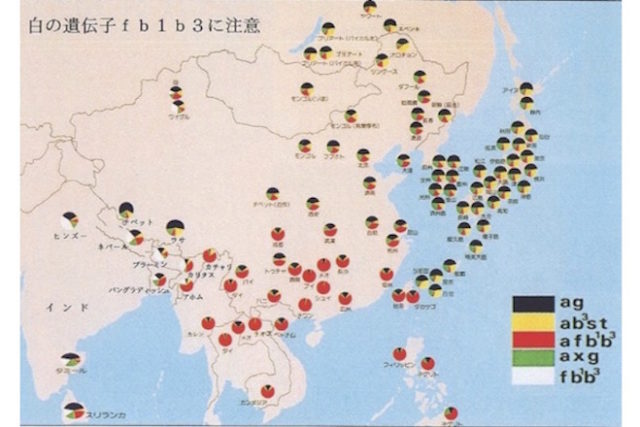
ON JUNE 15, we traced the origin of the Yayoi Japanese rice farmers (BC 300-AD 600) largely to Baekje, a former kingdom at the southern tip of the Korean peninsula. Identifying that source, however, still left me somehow unsatisfied. For then I had to know where the Baekje people came from. Clearly, they had to have come from the Asian mainland north of the peninsula. But where?
Further wandering the web to explore this question brought me to the human genetics map reproduced here, which simply stunned me. Its broad pattern implies that the Japanese descend from the people of northeast Asia—today the Lake Baikal region of Russian Siberia, Mongolia, and northeast China. It suggests that our distant ancestors essentially took the path south from Beijing to Seoul. Their “blue-headed” symbols contrast sharply with the “cherry tomatoes” that span southern China, Taiwan, and the Philippines.
At this point we need to know what the color-coded pie slices within each dot represent. Here, geneticist Hideo Matsumoto lays it out [with a few lay definitions added by me]. Writing in Human Genetics (1988), he states,
“Since the discovery in 1966 of the Gm ab3st gene, which characterizes Mongoloid populations, the distributions of allotypes [varieties] of immunoglobulins (Gm) [antibodies] among Mongoloid populations… from southeast Asia through East Asia to South America… can be drawn: (1) Mongoloid populations can be characterized by four Gm haplotypes [DNA sequences]…. ag, axg, ab3st, and af b1b3… [These] can be divided into two groups based on… [their] frequency distributions… the first is a southern group characterized by a remarkably high frequency of Gm afb1b3 [red code] and a low frequency of Gm ag [blue]… the second, a northern group characterized by a high frequency of both Gm ag [blue] and ab3st [yellow] but an extremely low frequency of Gm afb1b3 [red]. (2) Populations in China, mainly Han but including minority nationalities, show remarkable heterogeneity of Gm allotypes… and contrast sharply to Korean and Japanese populations, which are… more homogeneous… The Gm ab3st gene [yellow] which is found with the highest incidence among the northern Baikal Buryats, flows in all directions… this gene… is… found in high frequency among Eskimos, Koryaks [of Kamchatka], Yakuts [of Siberia northeast of Lake Baikal], Tibetans [northeast of India], Olunchuns [of eastern China], Tungus [of northwest of Lake Baikal], Koreans, Japanese, and Ainus…. On the basis of these results, it is concluded that the Japanese race belongs to northern Mongoloids and that the origin of the Japanese race was in Siberia, and most likely in the Baikal area of the Soviet Union.”
Professor Matsumoto reiterates these findings in a 2009 article, showing that they remain current (“The origin of the Japanese race based on genetic markers of immunoglobulin G,” Proceedings of the Japanese Academy; full text online).
I FOUND all of this remarkable, because it brings us back to the place where we began this “Roots” journey in April 2016. Then, I only thought naively that there was something “Japanese” about the face of Irina Pantaeva. I wanted to know more about the geographic distribution of such faces (discovernikkei.org). I did not know that addressing it would run seven columns across four continents (Africa, Eurasia, North America, and Greenland).
To summarize our wanderings, at first I had thought that “The Japanese” originated from the mixture of peoples from the north and south with the indigenous people of Japan. Inf luenced by older references about Japanese origins, I believed that the Japanese were essentially “made in Japan.” As my reading carried me onward, we learned the current thinking based on newer evidence. It is that the Japanese originated from a two-step process: (a) an early settlement of the islands by hunting and gathering native people, the ancestors of the Ainu; and (b) the overtaking of the first wave by the wave of rice farmers.
From here, I cannot help but wonder about a few remaining “loose threads” of this story. These, however, will not change the bottom line.
We are transplanted Buryat-Koreans. Perhaps that is why we like cold fish and hot pickled vegetables with our rice.







